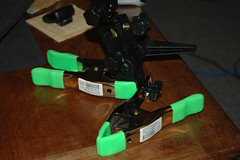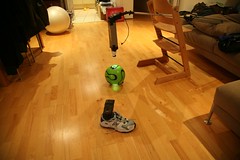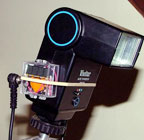
Long-time readers of Strobist will know that I am not a big fan of softboxes.
Maybe it is because of all of the light they suck out of my small flashes. (Umbrellas are more efficient.)
Maybe it is their cost, by the time you get them hooked up to a stand and an SB speedlight. (You have to get the box and then go doohickey shopping to connect it to a shoe unit.)
Or maybe it is just that I pretty much used them to death in the 80's and 90's.
But a softbox does offer a good balance of diffusion and control. And I will admit to still owning one.
About two weeks ago, I got an assignment that required reasonably soft light and total spill light control. I was going to photograph two elderly ladies in front of a (DLP) projected historical photo for a play they were doing about Baltimore's famous Cone sisters.
For this, I would need a source that could light them, yet completely avoid light spilling on a white background that was 10-12 feet away. (That wall would be for my continuous light projection surface.)
Sure, I could have used a hard light with a gridspot. But using that hard quality of light is not a real cool thing do to someone of that age.
So I dug into my closet and (literally) dusted off my old softbox I used to use ad nauseum with my trusty old White Lightning 600 monobloc. It is a Photoflex model from the '80's, and is about 24 x 30 inches - with some tweaks.
First, it has velcro on the front corners to take either of two, full-sized gels - a window green and a warming gel.
Second, it has black gaffer's tape dividing the front panel into six sections, like the panes of a window. (That makes for much nicer, more natural eye reflections.)
But the softbox needed more spill control, so I went shopping for one of those neat, fabric grid spots.
I am reminded at this point of the old joke wherein a guy gets revenge from a girl by having someone sit next to her for a few minutes at a bar. Then, without warning, they stand up and loudly say, "A hundred a fifty DOLLARS???" Then, they get up and walk away from her.
The implication, of course, being that (a) she is "for sale," and (b) she is
quite overpriced at $150.
Well, that's pretty much how I felt about the (very nice looking) fabric grid spots.
So I decided to take some inspiration from my scissors-happy five-year-old and make one myself.
Now, before I go on, I will say that the two items are not exactly equal. Mine is heavier, and designed for not-too-frequent usage. And it is made out of cardboard and tape.
But it cost about 5% of the price of the spiffy store-bought one, and for an infrequent softboxer like myself, it fit the bill.
Put differently, I could almost get another off-camera light, stand, umbrella, etc., for what I saved. No brainer.
How to Make a DIY Softbox GridspotWhat you'll need:
• For a medium-sized softbox, five or six pieces of thin, black poster board. I barely did it in 5. Get 6 to be safe. Mine were $0.89 each. The board should be at about the size of your softbox.
• Black duct tape. (You won't be removing this, so no need to use more costly gaffer's tape. You can get it for about $3.00 at a craft store, along with the poster board.)
• Silver sharpie (or a white crayon) to mark on the poster. Likely hanging around the house already.
• A straight edge, like a yard (or meter) stick. Will also be used for measuring.
• Scissors (or a razor knife and safe cutting surface.)
• Some 4th-grade math skills.
First, find a common factor for the dimensions of your softbox grid. Aim for something in the area of 4-6 inches.
You will want to make the grid a little smaller than the box, to use a friction mounting system. My box was 24 x 30, so my grid was 22 x 28. I went with a common factor of 5.5 inches. (5.5 x 4 is 22, and 5.5 x 5 is 27.5) I cut my poster board to be this size. (I had to trim 1/2 inch off of one side.)

Next, draw a 5.5 x 5.5 (my chosen common factor) grid on each sheet as shown, using solid lines. Then bisect that grid with a 2.25 x 2.25 (half the common factor) set of dashed lines, as shown.
Split the boards into two groups of three sheets each.
Cut one group on the vertical (5.5") lines and one group on the horizontal (5.5"). These will be your strips.
Tape two vertical and two horizontal strips together on edge - with the drawn lines on the inside - to make the perimeter of the gridspot.

Now, cut notches along the 2.25 lines (all of them, including the 5.5 multiples) on one long side of all of the rest of the strips. You will cut to the half-way line on each, that line having been provided by your (dashed) grid drawings, as shown.

Do not just cut a slice. Cut a shallow "V", to allow the grid to go together much more easily. This is important.
Once you have your vertical and horizontal strips notched, tape your center (or close to center if using an even number) vertical strip into the frame, notches up.

Working on alternate sides, tape the other horizontal strips in, notches up. Your drawn lines will tell you where to tape them for perfect spacing. You do not have to go nuts on the tape, either, You'll be using a lot in total.

Now, work your way through the verticals in the same way - but notches down. If you did not take the time to cut "V notches" your joints will be all squishy and bendy. Go back and cut "V" notches like I suggested.
If you made little "V's," your grid spot will quickly and easily start to come together, causing an almost uncontrollable urge to hit the "make a donation" button on the sidebar of this site.
(Hey, I'm just saying. It happened to me.)

Using small pieces of tape, fasten the edges of the strips to the insides of the frame. You do not have to tape each intersection - just the border areas. You'll finish up pretty quickly from here. I did mine in about 90 minutes total, but I was figuring out how to do it as I went.
Reinforce the corner edges with tape. Reserve any extra poster board to make a light-sealing "skirt" around the edges if you like. You will want it on at least one edge.
The grid will be heavier than you expected. But it should still hold OK by bending the softbox ribs and wedging them into the four (tape reinforced) corners of the grid spot. It will weigh your box down a little, so adjust the tilt angle of the strobe to compensate.
So, How Does it Work?Pretty darn good, actually.

As you can see from this photo, compared to the top one, the light falloff is absolute as you move a little bit away from the front of the box.
This is not a tiny gadget, and not the kind of thing you would travel all of the time with. But it works great to come out of the closet for that infrequent time you might need some serious light spill control. It will collapse on the diagonal an then you can loosely fold it in half.
Next: An On Assignment post detailing the photo that the grid was designed for.














 Flickrite
Flickrite 































